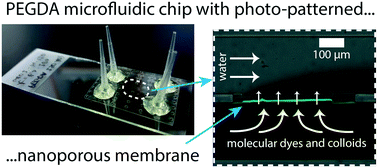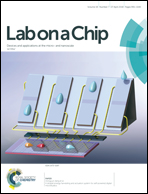In situ photo-patterning of pressure-resistant hydrogel membranes with controlled permeabilities in PEGDA microfluidic channels†
Abstract
We report the fabrication of highly permeable membranes in poly(ethylene glycol) diacrylate (PEGDA) channels, for investigating ultra- or micro-filtration, at the microfluidic scale. More precisely, we used a maskless UV projection setup to photo-pattern PEG-based hydrogel membranes on a large scale (mm–cm), and with a spatial resolution of a few microns. We show that these membranes can withstand trans-membrane pressure drops of up to 7 bar without any leakage, thanks to the strong anchoring of the hydrogel to the channel walls. We also report in situ measurements of the Darcy permeability of these membranes, as a function of the deposited energy during photo-polymerization, and their formulation composition. We show that the use of PEG chains as porogens, as proposed in [Lee et al., Biomacromolecules, 2010, 11, 3316], significantly increases the porosity of the hydrogels, up to Darcy permeabilities of about 1.5 × 10−16 m2, while maintaining the strong mechanical stability of the membranes. We finally illustrate the opportunities offered by this technique, by investigating frontal filtration of colloidal dispersions in a straight microfluidic channel.



 Please wait while we load your content...
Please wait while we load your content...